FREETOWN,
Sierra Leone — Before Sierra Leone’s capital of Freetown exploded into a
sprawling metropolis — eating up wooded hills and encroaching on the Atlantic —
Eugenia Kargbo loved it for the pristine beaches and lush forests that once
enveloped the city, and for its green landscape.
اضافة اعلان
Kargbo,
who grew up in the capital in the 1990s, would like to see the city reclaim
those vistas. And as Freetown’s first chief heat officer, a post created in
2021, that is her seemingly impossible mission: to make the city verdant and
livable again by helping it cope with rising temperatures and other climate
changes. These disruptions, along with decades of uncontrolled urban
development, have left the capital prone to deadly landslides and annual
floods, with heat waves almost all year long.
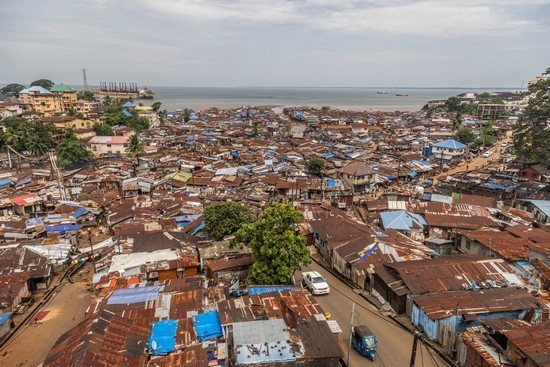 Overlooking Kroo Bay, where many homes are built from zinc
sheets, in Freetown, Sierra Leone, on November 17, 2022.
Overlooking Kroo Bay, where many homes are built from zinc
sheets, in Freetown, Sierra Leone, on November 17, 2022.
“Heat
is invisible but it’s killing people silently,” Kargbo said in an interview on
one of the top floors of Freetown’s city hall, a massive air-conditioned
building that towers over the dozens of informal settlements dotting the
capital of the small West African nation.
“Children
are not sleeping at night because of extreme temperature,” she said. “It
affects their ability to learn and their parents’ productivity.”
But
this is a city of 1.2 million people, where up to 60 percent of people live in
makeshift housing made of corrugated iron roofs and walls that turn the place
into an open-air oven most of the year. The country is one of the world’s
poorest; few people have air conditioning; and there is not nearly enough money
to finance ambitious fixes, Kargbo said. Where does one start?
Kargbo
is going for near-term fixes first. “People are suffering now,” she said.
A
35-year-old mother of two, Kargbo was a child when Sierra Leone plunged into a
decadelong civil war that left at least 50,000 dead. She studied at the
University of Sierra Leone and in Milan, and began her career as a banker.
As she
began raising a family, Freetown started suffering from hotter days and other
weather-related disasters, and Kargbo was drawn toward a role in government. In
2017, a landslide on the slopes of the capital that killed more than 1,100
people served as an “eye opener into the problems we faced,” she said.
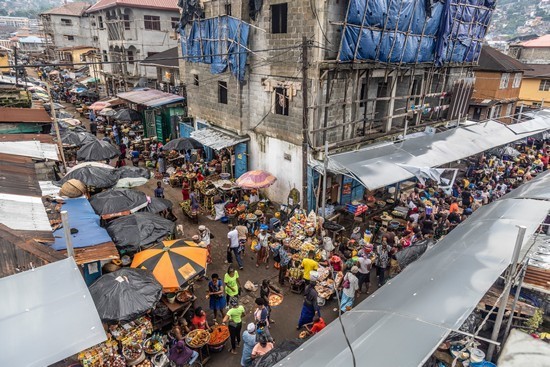 Newly installed market canopies at Congo Market in Freetown,
Sierra Leone, on November 17, 2022.
Newly installed market canopies at Congo Market in Freetown,
Sierra Leone, on November 17, 2022.
Kargbo’s
portfolio as heat officer is part of a broader plan known as “Transform
Freetown” that is championed by her boss, Mayor Yvonne Aki-Sawyerr. Her
position was created and funded by the Adrienne Arsht-Rockefeller Foundation
Resilience Center, part of the Washington-based Atlantic Council.
As heat
officer, Kargbo has installed a few public gardens that provide tiny oases of
freshness to elders sipping tea under the shade of trees. Her office has also
set up canopies in outdoor markets meant to protect vendors selling fish, meat,
and vegetables for long hours from the blazing sun. She wants to provide
buildings with white roofs that will reflect heat instead of absorbing it,
install public fountains and plant many, many more trees.
Kargbo
is also in charge of the city’s sanitation policies and has vowed to replace most
of the city’s illegal dumping sites with green spaces.
But
whether she can accomplish all this remains an open question.
Extreme
and lengthy heat can debilitate bodies; some of the far-reaching effects of
extreme heat are already taxing countries in much of the world.
Freetown
has an equatorial climate that brings little variation in temperature
throughout the year, and barely any respite at night.
Average
temperatures range from the mid-70s to the high 80s, with regular peaks in 37°C
and 43°C. In 2020 there were just over about 30 days with an average
temperature above 27°C throughout the
day. But by 2050, the city expects to have temperatures that high almost half
the year, according to predictions by Vivid Economics, a London-based
consultancy.
In Kroo
Bay, a settlement of 18,000 inhabitants just half a mile from Kargbo’s office,
families often sleep outside because it is too hot inside their homes at night.
“The
past summer in Europe made many people realize that global warming is happening
now, but here we’ve been witnessing this for years,” Kargbo said.
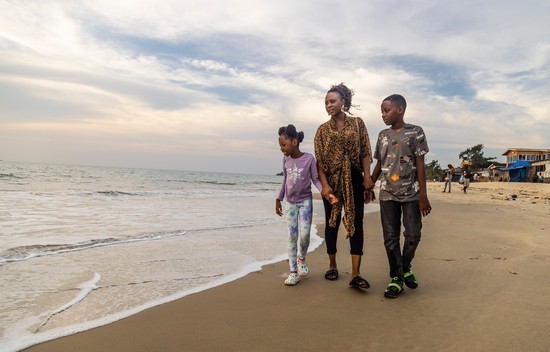 Eugenia Kargbo, Freetown's first chief heat
officer, with her children, Zoe and Dennis, at the beach in Freetown, Sierra
Leone, on November 19, 2022.
Eugenia Kargbo, Freetown's first chief heat
officer, with her children, Zoe and Dennis, at the beach in Freetown, Sierra
Leone, on November 19, 2022.
Kargbo
is one of seven women appointed chief heat officers by the Arsht-Rockefeller
foundation across four continents. Kathy Baughman McLeod, the program’s
director, said she hoped Kargbo’s job would be replicated in other African
countries.
“This
role or something similar will be popping up everywhere, because leaders will
need to have visible, tangible action to protect people,” Baughman McLeod said.
“Eugenia is the face of heat.”
But for
the moment Kargbo’s work, and salary, depends on foreign money. The World Bank,
UN agencies and private partners, like financial institutions, pay for her
projects.
“City
Councils in Africa are not well equipped to cope with key but not always
obvious phenomena” like rising temperatures or urban heat islands, said Wanjira
Mathai, a Kenyan environmentalist who called Kargbo’s work so far “remarkable.”
Last
fall, Kargbo was listed as one of 100 rising stars by Time magazine. And she is
working on a blueprint for a strategy to combat heat in other African cities.
Critics,
though, say she can have only limited effect because the problem is too large
for any one official to tackle alone. From uncontrolled sand mining on beaches
to mudslides from hills, “Freetown is a geographical hazard which can’t be
fixed,” said Alhaji U. N’jai, a professor of environmental science at the
University of Sierra Leone’s Fourah Bay College.
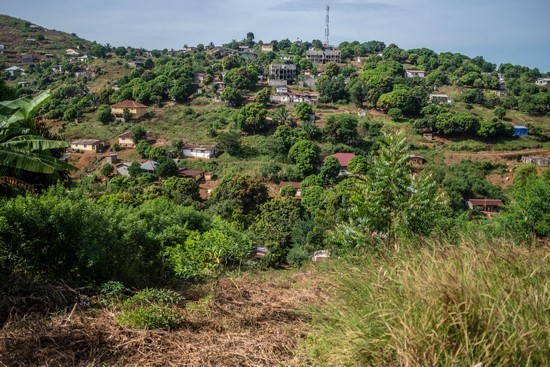 The neighborhood of Mayenkineh, one of the neighborhoods
benefitting from Eugenia Kargbo’s tree-planting project, in Freetown, Sierra
Leone, on November 17, 2022.
The neighborhood of Mayenkineh, one of the neighborhoods
benefitting from Eugenia Kargbo’s tree-planting project, in Freetown, Sierra
Leone, on November 17, 2022.
On a
recent afternoon, Kargbo walked unrecognized in Congo Market, one of the city’s
largest, where city workers have installed about 40 canopies made of Plexiglas
roofs to protect vendors from the heat. Many people around her were unaware she
was behind the initiative.
Much
more conspicuous was Kargbo’s boss, the mayor, Aki-Sawyerr, who arrived at the
market in an air-conditioned car and was greeted by hundreds of passersby as
she rolled down the window — the air conditioning still on.
Not all
the vendors had received a canopy. Many sheltered from the sun underneath beach
umbrellas covered with black plastic bags.
“Why is
there cover for some, and not for others?” Mavel Dixon, a 45-year-old vendor,
asked as she wiped sweat from her forehead and pointed at her stall.
Another
project championed by Kargbo that has attracted headlines is a plan to plant 1
million trees by the end of 2022. The initiative is nicknamed “Freetown the
tree town.” But a lack of funding has slowed the effort, with just above
550,000 trees planted. Of those, 450,000 have survived.
Kargbo
said the city’s challenges in dealing with problems of heat were compounded by
the fraught relationship that the government has with the administration of
Aki-Sawyerr, a former accountant who is in the opposition party.
“The
root causes aren’t addressed: Trees are still being cut down in Sierra Leone,
houses are still being built on hill sides, people keep using waste to encroach
on the sea,” she said. “We receive very little funding from the government, but
when a disaster hits, people turn to us.”
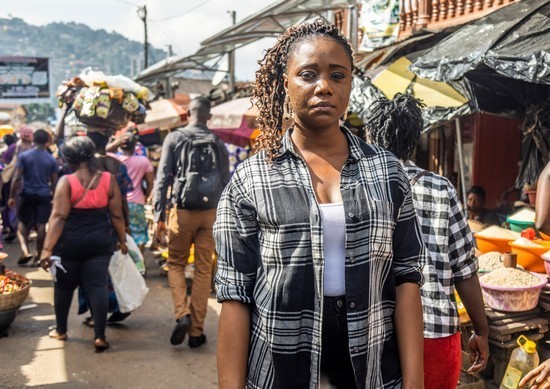 Eugenia Kargbo, Freetown's first chief heat officer, by
newly installed market canopies at Congo Market in Freetown, Sierra Leone, on November
18, 2022
Eugenia Kargbo, Freetown's first chief heat officer, by
newly installed market canopies at Congo Market in Freetown, Sierra Leone, on November
18, 2022
For
now, intense heat makes daily life in Freetown insufferable for many residents,
Kargbo said, with reports of heat strokes, dizziness, and kidney diseases. The
weather can also strain tempers.
“I also
snap at people when temperatures are high,” she said. “We don’t take notice of
it, but heat stirs up violence.”
Read more Odd and Bizarre
Jordan News



